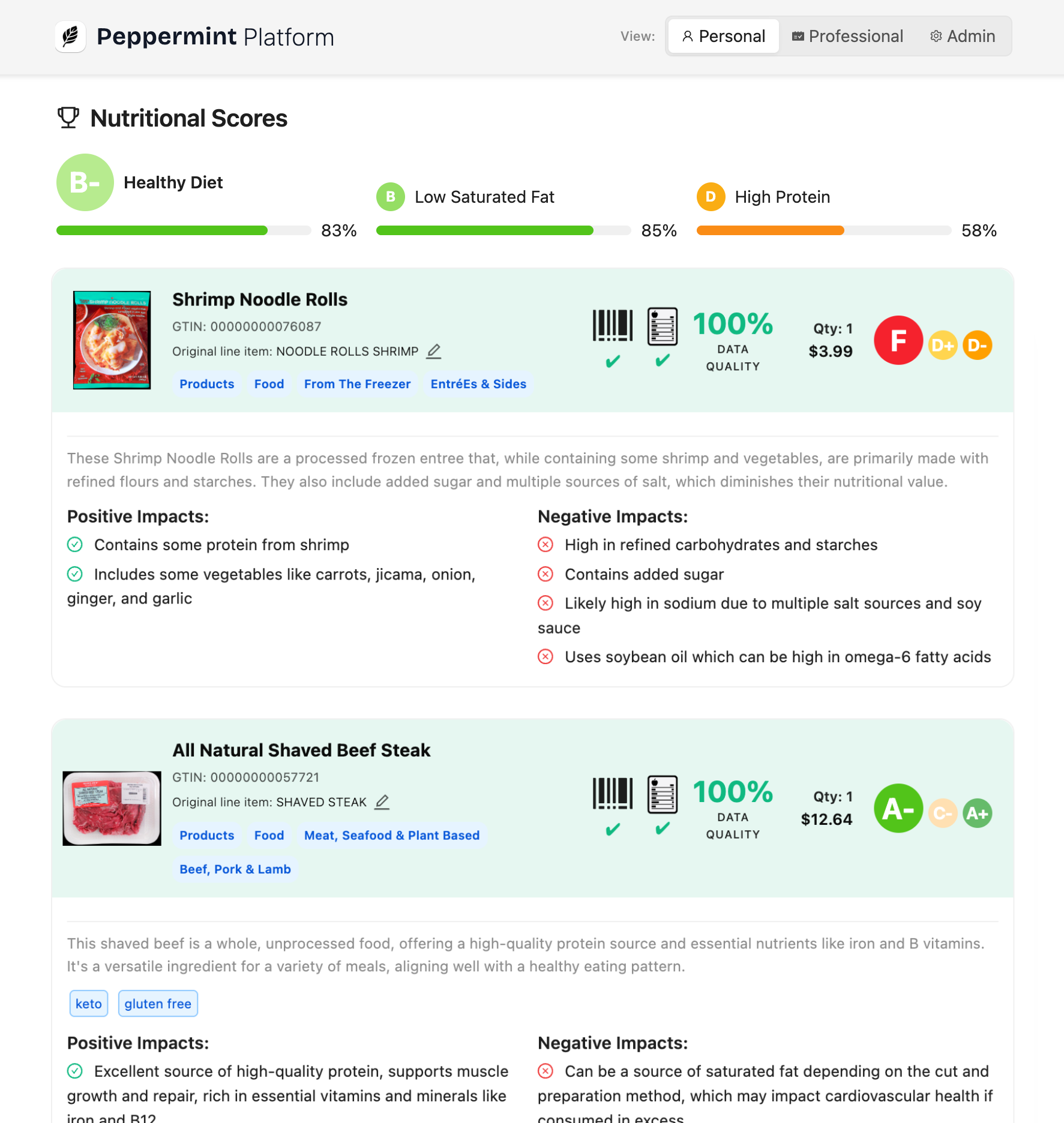
For Wellness Platforms & Coaching Teams
Shape what your clients bring into the house.
Real‑world food data from the weekly cart—passively captured via retailer link or receipts.
No food diaries, just confidence‑scored signals your coaches can act on.
Food diaries are broken. Every nutritionist knows it.
- Most clients stop logging within days. Health & fitness apps (incl. calorie/meal trackers) average ~12% Day‑7 retention (≈88% drop‑off).1
- 10–50% underreporting when self‑reported intake is validated against doubly‑labeled water (DLW).2
- “Forgetting to journal” is the most‑cited reason people miss entries.3
- Diet records are time‑intensive to collect and review: a single 24‑hour recall typically takes ~17–34 minutes, and dietitians spend ~29 minutes per patient on non‑visit care coordination (eg, record review and follow‑ups).4–5
In our conversations at HLTH 2024 and FNCE® 2025, dietitians and platform leads repeatedly described manual food logging as high‑burden and often underused.
Sources
- Adjust (2023): Health & fitness tracker retention benchmarks — Day‑7 ≈12%.adjust.com/blog/health-tracker-installs-and-retention-data
- Bailey RL (2021), Curr Opin Biotechnol: Overview of dietary assessment methods; DLW shows 10–50% underreporting.pmc.ncbi.nlm.nih.gov/articles/PMC8338737; see also Burrows TL (2019), Front Endocrinol.frontiersin.org/articles/10.3389/fendo.2019.00850
- Cordeiro F. et al. (2015): “Simply forgetting to journal” was the most‑cited reason for missed entries.pmc.ncbi.nlm.nih.gov/articles/PMC4755274
- NCI ASA24 FAQ (2024/2025): Typical 24‑hour recall completion time 17–34 minutes.epi.grants.cancer.gov/asa24/resources/faq.html
- Crouse J. et al. (2024): Outpatient dietitians spend ~29 minutes/patient on care coordination.pubmed.ncbi.nlm.nih.gov/37721196
Note: App‑retention stats are category‑wide; exact rates vary by cohort and app. “Diet records” refers to self‑report methods (paper/app diaries, recalls).
Power your coaching with real‑world food data.

Peppermint for Professionals
Access normalized purchase data and confidence-scored nutrition metrics. Track progress over time and equip coaches with reliable weekly signals—no food logging.
Signals dashboard & analytics
Weekly metrics and trends based on real purchase data
Client management
Track cohorts and progress with confidence-aware views
Coach-ready weekly brief
2-minute summaries and exportable reports your team can use
Wellness Platforms
Ship nutrition features fast—no food logs
Coaching Teams
2-minute briefs for better sessions
GLP-1 Programs
Reinforce habits with real-world food data
Corporate Wellbeing
Population-level wellbeing metrics
Three steps to weekly nutrition signals
How to connect grocery data, analyze purchases, and get weekly nutrition insights.
1. Invite & link
- Send an invite from your dashboard
- Clients link a retailer or text a receipt
- No food logging or labels required
- You’re notified when they’re connected
2. Sync & analyze
- Purchases sync after every shopping trip
- Items normalize to nutrition data with confidence scores
- Patterns emerge: timing, categories, trends
3. Metrics & insights
- Fiber, protein, and UPI deltas each week
- Item scores based on personal goals
- Integration‑ready exports for your tools
Features
What's Working Today (Private Pilot)
- Chrome Extension for Smith's/Kroger: Complete purchase history extraction
- Receipt Scanning: Walmart, Trader Joe's, others
- Advanced Nutritional Analysis: Health goals: balanced diet, low sodium, low sugar
- Professional Dashboard: Client management and insights
- Privacy Controls: Clients control all data sharing
Coming Q1-Q2 2026
- Albertsons/Safeway integration
- Automated client reports
- Practice management integrations
- Clinical exports (optional)
Frequently Asked Questions
Ready to get started?
Be the first to bring effortless nutrition insights powered by real-world food data to your clients.